Menu
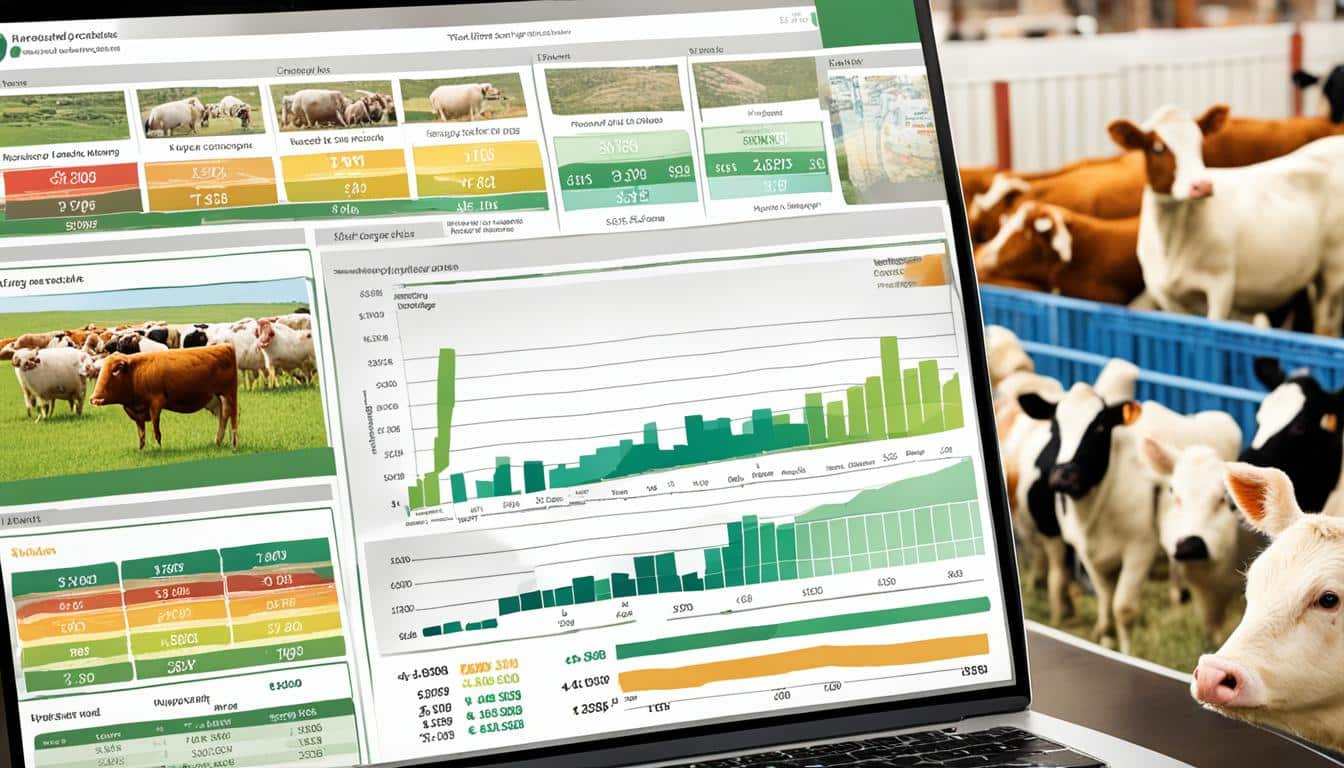
Feeder cattle receipts have dropped significantly from the past year. They decreased from 35,718 to 24,569. This shows how livestock prices can change a lot in the United States. An in-depth look into these changes highlights the complex nature of the livestock market.
The livestock market is complex and affected by many things. Things like local auctions or national trends play a big role. For example, Alabama has many livestock auctions every week in places like Dothan and Frisco City. Arkansas, too, shares detailed cattle auction reports from locations such as Searcy and Ash Flat. USDA and Barchart Solutions provide detailed data, helping us understand market trends better.
Knowing about livestock pricing is key for everyone from farmers to investors. In a fast-changing world, good data helps make smart choices. It ensures people can make decisions that keep their business or investments profitable and lasting.
Livestock prices come from many places, all affecting the market. For instance, 34 important packing plants in the U.S. share cattle data under federal rules. This makes up 92% of all cattle deals in the country. So, we have lots of data for good market insights.
There’s a lot of daily work to keep this data updated. Market Reporters look at 5,000-8,000 cattle records each day. The Agricultural Marketing Service then puts out 24 daily and 20 weekly reports about cattle prices. This gives everyone a wide look at livestock prices.
Livestock market data doesn’t just give facts. It shows exactly how the market is working every day. For example, some prices are set by discussing between the buyer and the seller. Others are set in advance, based on certain market prices found on the CME.
It’s also key to know what base price and net price mean. The base price is the original price of the livestock at the packing plant. The net price is what’s left after adding any bonuses or taking away discounts. This shows the real value of the livestock.
| Category | Description |
|---|---|
| Negotiated Purchase | Price determined via buyer-seller interaction, delivery within 30 days. |
| Forward Contract Purchase | Agreement executed in advance of slaughter, base price established by CME quotations. |
| Formula Purchase | Advance commitment of cattle for slaughter by any means other than negotiated, negotiated grid, or forward contract. |
| Packer-owned Information | Cattle owned by a packer for at least 14 days before slaughter. |
| Base Price | Price paid for livestock delivered at the packing plant before premiums/discounts. |
| Net Price | Price paid for livestock after applying premiums/discounts. |
This big network of livestock data helps everyone involved. It gives a full view of livestock prices and market trends. Thanks to accurate reports from places like Alabama and Colorado, we can build a trusted view of the livestock market’s complex world.
Recent data shows big changes in livestock market prices. These trends teach us a lot. We learn how different parts of the US affect livestock prices. This is due to several factors playing a part.

In 2022, the USDA’s Annual Cattle Inventory Report showed a 2% drop in cattle numbers. This meant 1,887,700 fewer cattle. prices. Even the 2021 calf numbers dropped by 1.2% to 35.1 million, adding to market pressures.
A few key market dynamics stand out:
The balances between these figures highlight the importance of market trends. They’re key to understanding livestock prices well.
Different states show very different market prices for livestock. For example, on May 1, 2022, there were 12 million cattle being fed, up 2%. This change is linked to feed costs, local demand changes, and farming techniques.
| Region | Inventory Changes (%) | Feed Costs per Head ($) |
|---|---|---|
| Midwest | -1.5% | 1,750.45 |
| Southwest | 2.0% | 1,802.58 |
| Northeast | -0.8% | 1,780.15 |
These differences show that local and larger economic situations affect prices. Also, the USDA projects lower meat and poultry eating per person in 2022. This shift impacts prices too.
These trends help stakeholders understand the livestock market better. By keeping an eye on these patterns, they can make smarter decisions. This is vital as markets always change.
Understanding cattle prices helps us see the big picture in livestock markets. In Iowa, prices are rising. Cattle are selling for $188 to $190 alive, and $298 to $300 dressed. This is $2 to $4 more than last week.
Cow slaughter has decreased, with 22,000 fewer cows killed this year. Yet, the weight of fed cattle is up. They now weigh 889 pounds, which is 31 pounds more than last year. This means the quality of the cattle has also slightly improved, reaching 84.40%.
In Oklahoma City, the market for feeder cattle and calves is stable. Most cattle sold there weigh over 600 pounds. Feeder cattle and calves at OKC West are also doing well. Their prices have gone up by $3.00 to $6.00. About 40% of them weigh over 600 pounds.
The link between cattle and corn prices is strong. As corn prices rise, so do beef prices. This is because nearly half of the corn fields are planted. The rain in the corn belt is also helping corn growth.
| State | Summary Type | Details |
|---|---|---|
| Alabama | Livestock Auctions | Daily, Weekly Summaries, Seasonal Board Sales, Special Cattle Auctions |
| Arkansas | Cattle Auction Summaries | Specific Days for Auctions |
| Colorado | Diverse Auction Data | Feeder Cattle, Dairy Sales, Stock Show Specials, Weekly Summaries |
| Florida | Cattle Auction Summaries | Daily and Weekly Summaries from Various Livestock Markets |
| Georgia | Cattle Auctions | Different Cities, Varying Sales Types |
| Illinois | Auction Summaries | Weekly, Seasonal Feeder and Replacement Cattle Specials |
| Indiana | Weekly Cattle Auctions | Different Livestock Markets |
| Iowa | Feeder Cattle Auction Data | Varying Days |
Sheep market prices change a lot because of many reasons. These include the time of year and how much sheep people want to buy. Knowing these reasons is very important for those working in the sheep market.
The price of sheep changes a lot throughout the year. This is more obvious in the sheep market than in other animal markets. It’s because sheep are born at certain times of the year. Plus, people buy more around Thanksgiving, Christmas, and Easter, especially lamb, which then costs more. After these holidays, prices usually go down.
The hay supply in the U.S. is doing well, with 37% more than last year. This extra hay has helped keep sheep food prices stable. But, prices for baby sheep (feeder lambs) are about the same as last year. Sometimes, though, they are cheaper than usual.
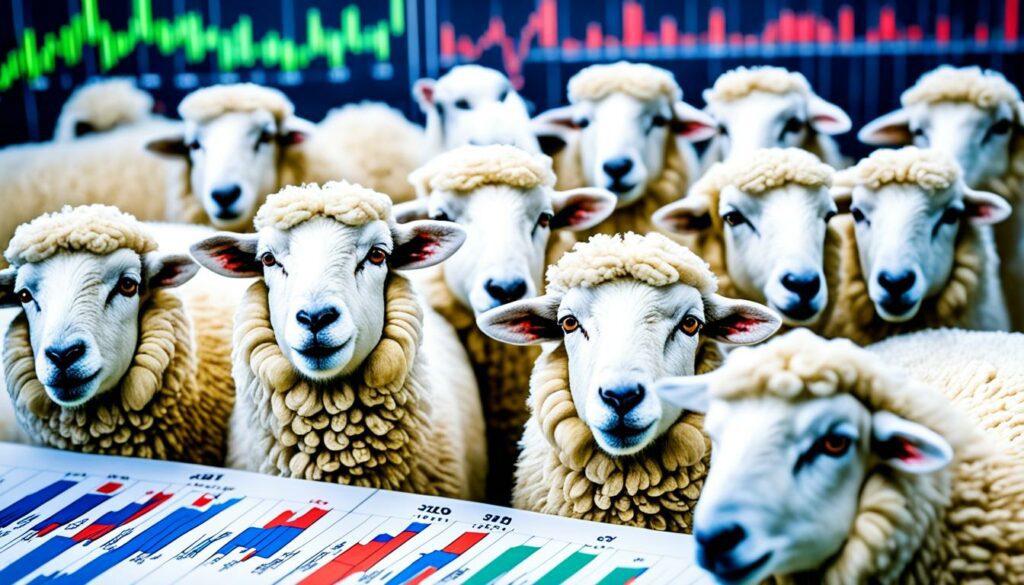
How many sheep there are and how much we want them affects prices greatly. There seem to be enough mom sheep (ewes) to keep the industry steady. This is because more lamb is in stores thanks to the pandemic, even though there’s a bit of a shortage.
This year, there might be a lot of corn in the Midwest, which could make feeding baby sheep easier. The forecast also says there will be more meat and chicken in 2020 and 2021. This means sheep farmers will have to compete more with other meats, like pork and beef. It’s a tough competition, especially during holidays when people eat a lot of meat.
| Year | U.S. Hay Stocks Increase (%) | Feeder Lamb Prices (Year-over-Year) |
|---|---|---|
| 2020 | 37% | Similar to Last Year |
Shopping, eating out, and how many sheep farmers sell all affect the sheep market. The market changes a lot, so understanding sheep supply is really important. This helps people in the sheep market know what to expect and how to do well.
To get animal market prices, it’s important to see how each livestock type works in its own market. Looking at what affects prices helps people make smart choices.
It’s key to figure out the differences between livestock types when pricing animals. Cattle, sheep, goats, and hogs all have unique qualities and market patterns. In Alabama, you’ll find auctions for different animals, showing varied prices and demand.
In places like Arkansas and Colorado, there are cattle auctions. They look at things like bone structure and growth potential to set prices.
Reading market reports helps understand how different animals are doing in the market. These reports change by auction and day, showing the market is always moving. For example, in Iowa, cattle auctions in places like Centerville can offer market insights.
| State | Major Livestock Auctions |
|---|---|
| Alabama | Alabama Livestock Auction, Ashville Stockyard, Dothan Livestock Co. |
| Arkansas | Ash Flat Livestock, Benton County Sale Barn, Hope Livestock |
| Colorado | Centennial Livestock Auction, Livestock Exchange LLC, Winter Livestock Inc. |
| Florida | Arcadia, Lakeland, Ocala, Webster |
| Georgia | Calhoun Stockyard, Duvall Livestock, Moultrie Livestock, Southern Livestock |
| Illinois | Fairview Livestock, Greenville Livestock Auction, Reel Livestock |
| Indiana | Indianapolis Stockyards, Shipshewana Livestock, Topeka Livestock Auction |
| Iowa | Appanoose County Livestock, Bloomfield Livestock Market, Clarinda Livestock Auction |
To know about animal market prices, you need detailed study and to keep up with the market. Every livestock type, like steers and heifers, has its own qualities that affect their price. For instance, cattle with thin flesh can cost more because they can grow a lot. Yearling cattle often sell better than calves.
It’s also helpful to look at auction reports and talk to auction owners. These reports tell you what kind of livestock is selling and for how much. They help spot trends and make smart moves, staying ready for market changes.
It’s key for those interested in the market to grasp *livestock market data sources*. I will show how using trusted sources can open up the data. This includes looking at auction reports and info from the USDA. They give us a clear guide on how to read the data right.
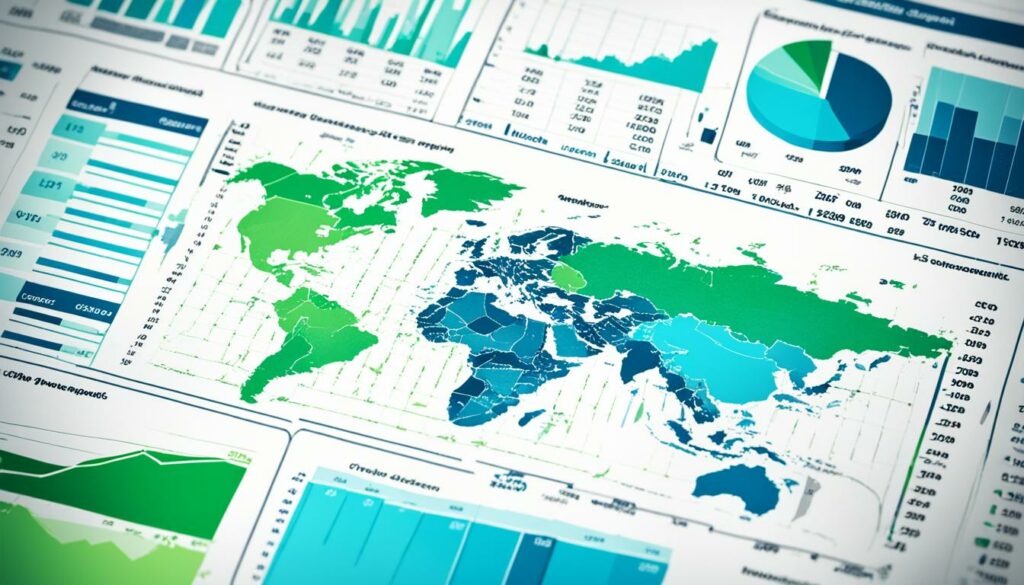
Understanding market numbers is about knowing different measures that affect prices. I look at auction reports from specific states and nationwide overviews. For example, I keep an eye on the sales of feeder cattle in places like Alabama, Arkansas, and Colorado. This paints a picture of what’s happening locally and across the country.
| State | Key Auction Locations | Report Types |
|---|---|---|
| Alabama | Uniontown, Arab, New Brockton | Daily & Weekly Summaries |
| Arkansas | Searcy, Hope, Heber Springs | Weekly Summaries |
| Colorado | Fort Collins, Brush, La Junta | Livestock Auction Reports |
| Florida | Ocala, Okeechobee, Madison | Individual Reports |
| Georgia | Calhoun, Athens, Donalsonville | Auction Data |
Mixing all these reports is crucial. It helps us understand what’s going on in the market. Spotting trends and noticing changes in prices becomes easier. This is vital for making smart decisions based on the data.
Getting info from *reliable livestock pricing sources* is a must. Groups like Barchart Solutions and reports from the USDA give real and current data. They ensure people are up-to-date with the market’s conditions. Using these kinds of sources makes dealing with complicated market data simpler. It makes creating solid market plans possible.
Understanding market prices for livestock is key. By using detailed data, experts can find patterns, study changes, and predict the future.
There are many ways to look at livestock market prices. Fundamental analysis focuses on the economy, the balance of supply and demand, and market state. For instance, watching how cattle auctions change over the year in places like Alabama and Arkansas helps predict what prices might do. Data from sales boards, auctions, and cattle specials are important for figuring out true market values.
Technical analysis, on the other hand, looks at charts and measures to spot trends and patterns. It uses tools like moving averages and volume analysis to guess how the market will do.
Many tools help experts keep an eye on the market and guess what might happen. These offer old and new data, as well as predictions.
Using these methods and tools can lead to better prices and more profit. By blending both basics and new ways, professionals can deeply understand the market. This helps in making smart choices.
Livestock market summaries show us how prices differ across areas. They tell us about recent market trends in various US places. For example, in Alabama, there are many reports from Livestock Auctions on different days.
Arkansas gives a lot of information in their Weekly Cattle Auction Summary. Chunky, Colorado, shows data on Feeder Cattle Auction and Stock Show Specials.
Florida’s summaries cover different Cattle Auctions by location and day. Georgia displays its market with Daily and Weekly Cattle Auction Summaries. It includes other auctions to show the state’s wide market scene.
Illinois and Indiana both list Weekly Cattle Auctions and special reports. These include Feeder and Replacement Cattle auctions. They highlight important events in the livestock market well.
I noticed Iowa’s focus on Feeder Cattle Auctions. They provide details on different locations and auction days. This shows how various states present livestock market information. They cover events for Replacement and Feeder Cattle sales, showing how the market changes over time. Various Monthly Feeder Cattle Special events show market activities peaking at times.
“Looking deeply into market summaries brings out interesting price trends. These reveal the unique local market conditions, especially in places like Oklahoma and Texas.”
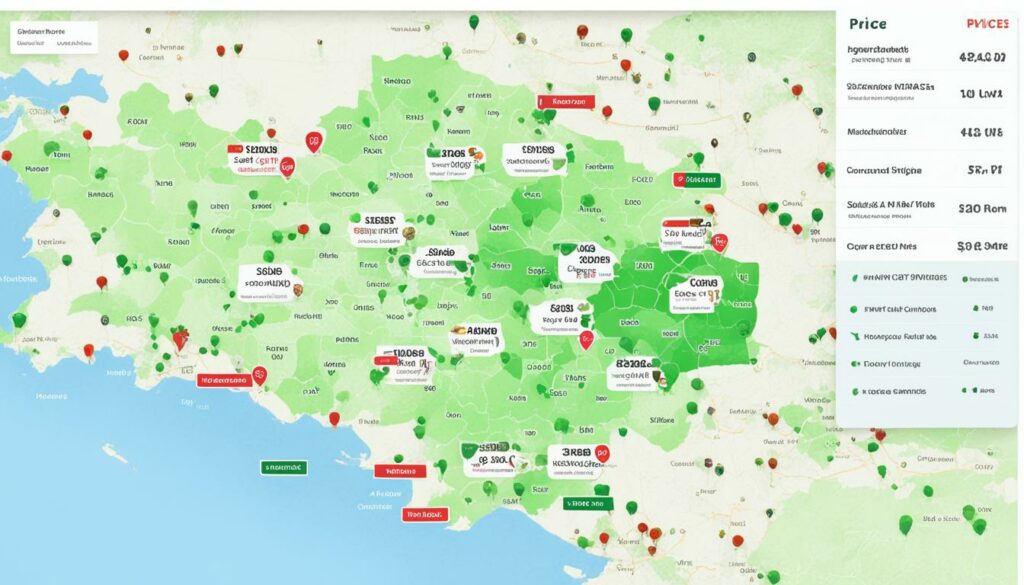
In Alabama, there are big livestock places like Montgomery Stockyards. Georgia has major market sites such as Northeast Georgia Livestock. Kentucky is home to auction sites like Blue Grass Stockyards and Livingston Co. Livestock Market.
Tennessee showcases livestock centers including the Dickson Regional Livestock Center. In Texas, Cattlemen’s Livestock Auction and Producers Livestock Cattle Auction are significant. Lastly, Wyoming highlights Torrington Livestock Auction as an important venue.
| State | Notable Auctions | Special Summaries |
|---|---|---|
| Alabama | Montgomery Stockyards, Arab Livestock Market | |
| Arkansas | Weekly Cattle Auction Summary | |
| Colorado | Feeder Cattle Auctions, Stock Show Specials | |
| Florida | Various Cattle Auction reports | |
| Georgia | Northeast Georgia Livestock, Calhoun Stockyard | Daily/Weekly Auction Summaries |
| Illinois | Weekly Cattle Auction Summary, Feeder/Replacement Cattle Specials | |
| Indiana | Weekly Cattle Auction Summary | |
| Oklahoma | McAlester Union Stockyards, Tulsa Livestock Auction | |
| South Carolina | Low Country Livestock Exchange, Laurens Livestock Exchange | |
| Texas | Cattlemen’s Livestock Auction, Producers Livestock Cattle Auction | |
| Washington | Toppenish Livestock Auction | |
| Virginia | Roanoke-Hollins, Culpeper Ag Enterprise | |
| Wyoming | Torrington Livestock Auction |
USDA livestock reports are key to understanding the agricultural market. They provide lots of info on livestock, like cattle sales, and special events across states. These states include Alabama, Arkansas, and Colorado.
The USDA gives out weekly and monthly summaries on livestock sales in local auctions. For instance, Alabama has auctions on Tuesdays, Wednesdays, and Mondays, while Arkansas chooses Mondays and Thursdays. These detailed reports help spot trends and see how the market is moving. They give a broad view through data from different times, which makes it easier to predict and make smart choices. This is good for learning about the agriculture market.
USDA reports affect market prices a lot. They show price trends and sale amounts, like those in Illinois and Indiana. These reports not only tell about the current market but also affect how confident people are in the market. With this knowledge, those involved can understand the market better. They can then adjust their plans to do better and last longer in the market.
Livestock futures trading affects how we predict livestock prices and how the market works. Speculators and hedgers are key players in this. They help manage price risks. But, a high number of speculators lose money. This shows the market is very changeable.
Speculators try to make money by predicting changes in livestock prices. Hedgers use the market to protect themselves from these changes. This balance is crucial for how livestock prices are influenced.
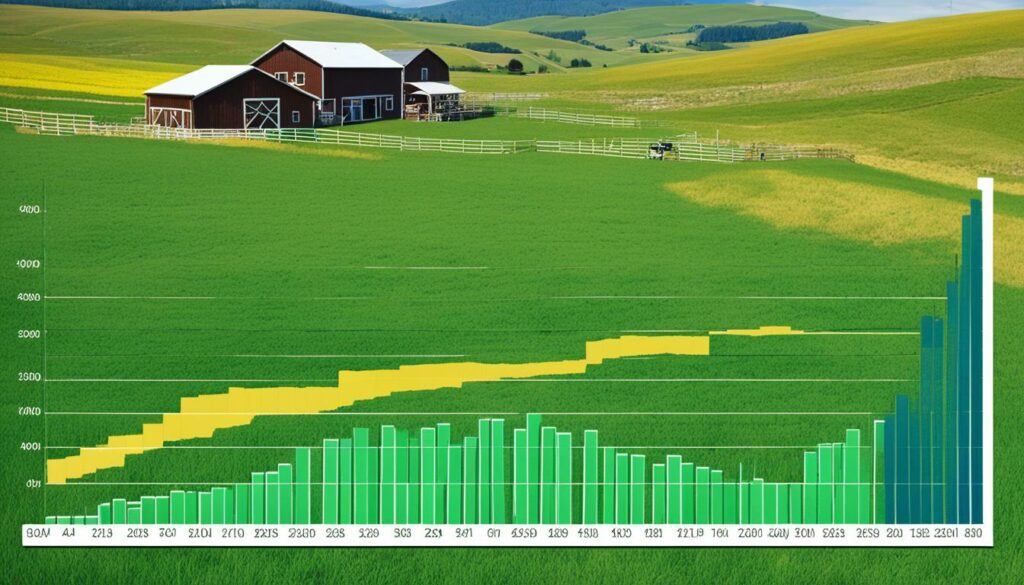
Between October 18 and October 23, market prices for cattle changed a lot. For example, January Feeder Cattle went down by 6.5%. These changes show how futures trading impacts livestock prices and market stability. It’s vital for analysts to keep up with these shifts.
In the U.S., the cattle industry is under pressure. More cattle were being prepared for market in 2023 compared to 2022. But, fewer were sold. This led to a big decrease in sales. These are some of the challenges the industry faces.
| Factors | Cattle on Feed (% Change YoY) | Cattle Marketed (% Change YoY) |
|---|---|---|
| October 2022 | +1% | -11% |
| September 2023 | +6% | -11% |
Livestock futures are also hit by wider financial issues. In 2023’s second quarter, more than half of new farm loans had very high interest rates. This puts a lot of pressure on farmers. Extreme droughts in states like Texas and Oklahoma make things even harder.
In short, livestock futures trading is complex, mixing speculation with real economic needs. It offers tools for risk control but is still very volatile. Understanding the market and having a good plan are crucial.
The livestock market faces big challenges today. These come from both money issues and the planet’s health. People involved are working hard to keep things running well.
Prices for livestock show a big change because of the economy. For instance, the cost of slaughter steer is now $140 each. This is up by 17.5% from last year’s price. The higher prices are due to feed costs also going up. Feeding a 760 lb. yearling steer now costs $1,802.58. This is a 22% increase from a year ago.
Other costs beyond feeding have also increased, reaching $144.19 per animal. This is 8% more than last year. The minimum price farmers need to sell at profitably has also grown. It’s now $138.66 per hundredweight, a 12.8% rise. All these costs rising means selling prices go up too.
The USDA’s LRP program is helping more and more farmers manage these risks. Since 2017, enrollment has gone from under 100,000 to over 5 million. But, some ways of using this help, like taking more subsidies than needed, might make the market go out of balance.
Weather and other environmental changes are also making prices shift. They impact how much livestock can be grown, which then affects prices in the market. For instance, the number of calves born in 2021 dropped by 1.2%. This was 35.1 million animals. The count of cows also fell by 2.3%, to 30.1 million cows in 2022.
Changes in how many animals are being killed for meat also change the market. In April 2022, around 2.81 million cows went to be slaughtered. This includes lower numbers for female cows compared to the year before. In contrast, more male cows were slaughtered, with a 7% increase in March 2022.
Changes in how much meat we eat also link to the environment. The USDA expects a drop in how much beef we send to other countries by 2022. Also, Americans might eat a bit less beef, chicken, and pork. But, the U.S. is buying more beef from abroad. Brazil, for example, has increased its meat sales to the U.S. by 29% by March 2022.
| Factor | 2021 | 2022 | Change (%) |
|---|---|---|---|
| Slaughter Steer Prices ($/cwt) | 119.15 | 140.00 | 17.5 |
| Feed Costs ($/head) | 1,477.52 | 1,802.58 | 22.0 |
| Calf Crop (million head) | 35.5 | 35.1 | -1.2 |
| Cow Inventory (million head) | 30.8 | 30.1 | -2.3 |
| Beef Exports (forecast %) | 0.0 | -1.8 | -1.8 |
Recent livestock auctions give us important hints about today’s market. By looking closely at auction trends, we learn a lot about selling farm animals. This helps us see the deeper patterns in how livestock is sold and what it means for the market.
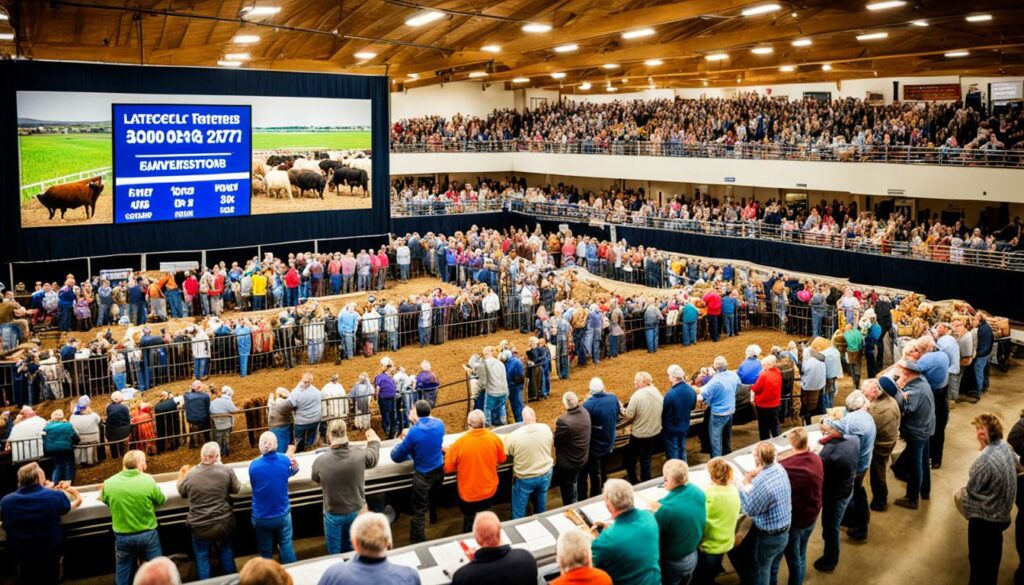
Different auction methods affect the prices animals fetch. For example, auctions with high-tech systems might give more accurate information. This means buyers and sellers can trust the details more. Being sure about prices is key for smart decisions.
Even animals of the same weight can sell for different amounts. This happens based on things like their build and quality, which auction houses often grade. Knowing about these grades can help sellers do better.
There are many ways animals can be sold at auctions. This variety can change how prices are set. It shows the many options people have when buying and selling livestock.
My daughter has noticed prices going up at auctions over the last three years. This shows the market is strong. At the same time, more people are asking about how auctions work. This means there’s growing interest in this area.
The profit from selling animals can change, depending on their weight. Lighter animals might earn more profit. But, don’t be fooled by the high prices. It’s still important to be careful when selling.
The cost of animal deaths affects how much money you make from the sale of other animals. This can cause prices to go up. It also affects new buyers. They might not be able to buy as much as they’d like.
| Type of Sale | Method | Price Variation | Key Insight |
|---|---|---|---|
| By Head (HD) | Individual animal | High | Reflects unique attributes |
| By Weight (WT) | Total weight | Moderate | Focuses on mass |
| As Pair (PR) | Two animals | Variable | Dependent on pairing |
| Group Weight (GW) | Total weight of group | Stable | Emphasises bulk sales |
| Group Head (GH) | Total animals in group | Moderate | Reflects quantity |
| Group Pair (GP) | Pairs within group | Variable | Quality and pairing |
Understanding how auctions work is crucial for everyone involved. It lets us use the market to our advantage. This knowledge helps make the livestock industry more successful.
Government policies shape the livestock market a lot. They include many rules, rewards, and help schemes. These make a big difference not just locally but across the country too. The Biden administration, for example, is making big changes that are helping livestock producers and changing how competition works in the meat business.
The Biden administration is trying to make the meat industry more open and fair. It wants to stop big companies from dominating the market. This effort helps keep livestock prices steady. For example, the sale prices of feeder cattle in places like Alabama, Arkansas, and Colorado can change because of these new rules. Local auctions, like those in Alabama’s Cullman Stockyard and Arkansas’s Cleburne County Livestock, show how markets are adapting to these policies.
Regulations do more than just ensure competition is fair. Bodies like the USDA and the U.S. Environmental Protection Agency help keep the market stable. The USDA offers ways to protect against lower prices, and the EPA makes rules for managing livestock waste. The USDA also runs the Mandatory Price Reporting programme since 2001, which helps in sharing price information. All these steps work together to shape the livestock trading scene.
Knowing current livestock market prices is key for good decisions about buying and selling. It’s important for everyone from farmers to investors. Understanding the market helps make sure you are profitable and sustainable.
Data from the livestock market is vital. It affects how prices are set and how well the market does. Reliable data sources, like Barchart Solutions and USDA reports, help people spot market changes. This lets them adjust their plans.
Economic conditions, what consumers want, feed costs, and the weather all play a role. These factors are seen in different prices across areas. They also cause prices to change a lot in places like Iowa.
Looking at cattle prices alone is crucial. Their prices can show us big things about farming as a whole. It’s useful to check feed costs, what people want, and reports from places like Arkansas and Indiana.
The time of year really affects how much sheep cost. When many animals are for sale or few, prices go up or down. This is often linked to when new sheep are born or the wool is cut.
Prices change based on the type of animal, who wants them, and where they are sold. This information is crucial for anyone looking to buy, sell, or plan. It helps in understanding the market and making good choices.
The best sources for livestock market data are Barchart Solutions and USDA reports. They give detailed and up-to-date info on the market. This helps people make smart decisions.
Looking at livestock prices uses many methods. These include checking the basic facts and looking at market data. The goal is to understand what the market might do next. This helps in planning ahead.
Summaries of regional markets show what prices are like in different areas. They are great for understanding the local scene and finding good chances to grow. This is especially helpful in states like Oklahoma and Texas.
USDA reports are very important. They tell us about the market every week and month. These reports help shape what people think about the market. They also show how healthy the market is and what consumers might do.
Futures trading helps keep livestock prices stable. It lets people guess what prices might be in the future. This system is good for making sure the market remains steady.
The livestock market faces a lot of issues. Things like feed costs, what consumers want, and the weather are big problems. These issues can change prices a lot. They require smart plans to handle them.
Recent auctions give us a real look at how the market is doing. They show us what’s selling well or not and at what price. This data helps people see what’s changing in the market.
Government rules really shape the livestock market. For instance, how the Biden government deals with how meat is processed matters a lot. These policies can change the rules and influence how farmers and companies work.